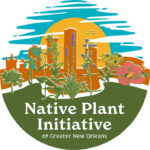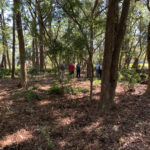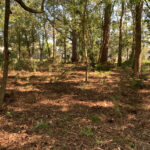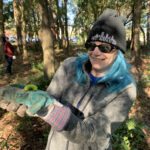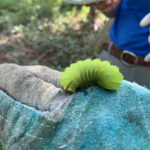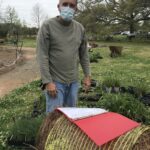Contributed by Robert Shaw - January 2024
Kill some of your lawn, maybe, or better yet, Kill your traditional lawn maintenance practices because for some people in some places, the native St. Augustine grass that many of us inherited along with our yards might be the best option to meet certain needs of small city yards typical of New Orleans.
I want to share my appreciation of St. Augustine grass - - but not how it’s typically managed. Look beyond the rallying cry of killing one’s lawn and consider the benefits of certain applications of this fairly able and certainly willing native groundcover: tough under feet, soccer balls and car tires; requiring little attention or maintenance (seriously, read on); providing an off-season soil-protecting cover and nursery for many plants native and otherwise, etc.

So the problem is not with Stenotaphrum secundatum (St. Augustine grass), it’s with the expectations and conventions for its use as a lawn and the management that typically follows - - frequent mowing, bags of weed-n-feed, fungicides, etc. Consider, though, if you haven‘t seen for yourself: what happens to a small patch of St. Augustine grass if it is neither watered, nor fed, nor treated with broad-leaf herbicides, and cut back as little as possible, perhaps to string-/trim a border to show that the management is intentional? It doesn’t grow tall enough to earn the attention of Code Enforcement - - whoever would come knocking about the height of your “weeds”, if anyone ever would. And so you can easily manage a small patch of St. Augustine grass with just an occasional string-trimming. I’ve never fertilized, watered, nor treated the grass with broad-leaf herbicides, fungicides, irrigating, etc, and it does just fine. Although lawn mowers can rarely be set high enough for this purpose, many plants, including native wildflowers - - Carolina petunia, cranesbill geranium, lawn American aster, etc., can survive typical mowers.


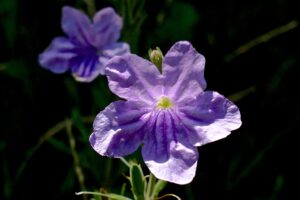

Over the years, I’ve expressed most if not all of the sentiments typically found in a “kill your lawn” article or post. I could dig up articles I wrote for a newspaper column back in 1982 about the useless waste of resources, etc. that a typical lawn involves. I still roll my eyes at huge houses perched on huge lawns that no one seems to ever play on, with a little wrought iron bench that no one ever seems to sit on. I’m somewhat amazed by suburban neighborhoods where there’s a popular pattern of mower tracks on the finished lawn - - circular, linear, or even cross-hatched for those who really get off on it. Over time, we have replaced about most (around 80%?) of the lawn grass area that came with our house. In recent years, I’ve taken to nibbling away at the small bit of lawn that’s left, smothering an occasional section with a big piece of cardboard, composting leaves and organic material, and then turning it over to the coneflowers, penstemon, and other native plants. But we’ll probably never get rid of this last little bit, nor the grass out by the street. “Kill your lawn” might make sense for some people and situations, but more likely only partly so for others.
Besides traditionally functioning as the presentation setting for the house (curb appeal, safely sterile, etc.), I understand that for many people, the attractiveness of having a conventional lawn is that mowing the lawn presents probably the least thoughtful and least involved approach to maintaining a landscape. Other than knowing how to handle a mower, you don’t have to know a whole lot. You don’t have to know a single thing about a single plant, except perhaps the grass you’re mowing and a few “weeds” you’re trying to eliminate, and maybe not even that. Obviously, people who maintain a “spotless” lawn would disagree, after all the money spent on typical lawn care products. And I’m not even touching the psychology of lord-of-the-manor / man-against-nature / salute to wealth and power / need for control or any of the other interesting suggestions about our attachment to lawns we read from time to time.
But keeping in mind that everyone’s situation is different, with these comments I’m considering typically small- to occasionally medium- sized New Orleans lawns. Right off the bat, there are reasons why one would not want to kill off all of their lawn (as well as reasons to do so, if desired).
- If you have kids or have kids over, they need room to throw and kick balls, chase and tumble around, etc. You can’t play catch in the middle of the coneflowers.
- If you want a little blanket-sized patch in the shade to be able to lie down with a book and cat or picnic, grass is where you want to sit, not on the Rudbeckias.
- If it’s the first of May (hooray, hooray… but not in the Salvia, for heaven’s sake)
- And of course there are more important issues, like:
What other ground cover can you drive over repeatedly in the road-side strip between sidewalk and street? Even if people don’t normally park on your strip, they will at Mardi Gras, for construction work on your block, etc. A lot of Uptown, for example, was laid out with little knowledge of a future of private vehicle parking, especially multiple vehicles for a family.
- people need to open car doors and get to the sidewalk. I can’t plant shrubs that block people trying to get in and out of cars, or plant flowers that people may or may not find a way to step around.
- St. Augustine grass on the ground is better than nothing, at least. It breaks up rain and sun impact and doesn’t seem to let any soil get away. That in itself seems pretty major.
- The grass actually ends up as an occasional nursery for self-seeding natives that are near-by. I’ve “rescued” blanket-flower, bee-blossom and others to transplant from the lawn to other places, and left others (lawn American aster, Malvastrum, etc.) to fend for themselves with occasional traffic, blankets and weed-whacking. In late winter, I let the streetside grassy strip go without cutting back as long as possible, and for a while you can barely see the grass blades for the cranesbill geraniums, false onion and non-natives such as the introduced Oxalis and white Dutch clover.
No, it doesn’t attract insect-pollinators with its non-showy wind-pollinated flowers (although the pistils and stamens are quite beautiful when you’re down at their level), but does serve as habitat for at least a couple larval stages of insects. And protects the soil ecosystem beneath it, at least.
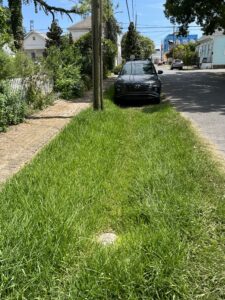



If you need a fairly carefree native plant that covers bare spots (and concrete and brick remains of civilization), that you can also drive and park on, and open car doors into, wrassle with the dog or cat on, lie down in the shade to stare up at the leaves and sky… I just don’t know a better one. F(r)og-fruit has successfully invaded the St. Augustine grass, as have other plants (non-native Dutch white clover, etc.), but none of them can handle the job year-round by themselves.
For your convenience, a map of its range all across the Gulf South, from BONAP: http://bonap.net/Napa/TaxonMaps/Genus/County/Stenotaphrum
I’ll see if I can find a complete list of the native plants that voluntarily appear in the lawn, but they include: fogfruit, Carolina geranium, false onion, Gaura, Coreopsis, blanketflower (Gaillardia), elephant’s-foot (Elephantopus), Salvia, Malvastrum, and of course some non-natives like white clover and lawn Oxalis. So even if you’re going to kill your lawn, try killing the typical maintenance practices first, and in the meantime appreciate the temporary and effective ground cover that you’re about to uproot or smother or otherwise do away with.
* * * * * * * * * * * * * * * *
Here's where some of the grass has been smothered with cardboard, mulch, etc., two years prior in the foreground with the coneflowers, and only one year before in the background by the fence.
